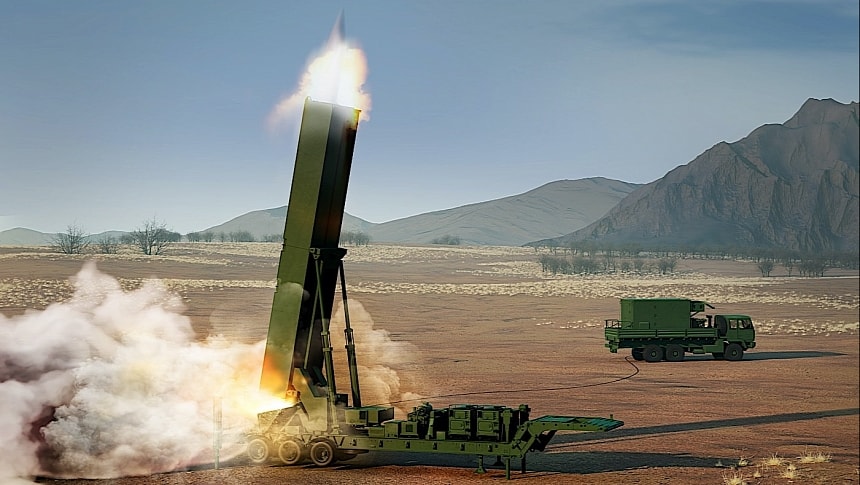There are a number of advantages for the military to use hypersonic weapons, but one of the most important is the fact that these things are so fast they're almost impossible to intercept and defeat before they strike their targets.
Hypersonic means going at speeds of over between Mach 5 and Mach 10. Just to give you an idea of how fast that is, consider Mach 5 means five times the speed of sound, or 3,836 mph (6,173 kph). Double those numbers and you get a sense of what Mach 10 means.
There are a number of programs the American military is currently running in the hope of developing the most capable hypersonic weapons possible, including the U.S. Navy's Conventional Prompt Strike (CPS) and the Army's Long Range Hypersonic Weapon (LRHW).
We've encountered these acronyms before, as the States have been at it for several years now, but this week, one of these programs, the LRHW, just got a major push forward after the U.S. Army awarded a big contract for hypersonic weapons deployment.
The contract's value is $756 million, and the money will go to defense contractor Lockheed Martin, one of the biggest players in the LRHW program. In exchange for that, the company will have to deliver additional such weapons systems.
What the LRHW means in Lockheed Martin's books is a ground-based hypersonic weapon system, which means ultra-fast missiles that can be launched from mobile ground platforms. The plan for their deployment is simple: Army trucks will carry two of these missiles each, installed inside dedicated launchers.
The Army plans to field these weapons on M983 trucks with trailers, with four of them, each carrying two missiles, forming a battery. The weapon itself is designed as a glide body, with a nose cone on its tip.
The way the weapon works is pretty simple. Once fired, the LRHW uses a rocket to reach the desired altitude and speed, at which time the glide body is released and it heads towards the target. The rocket itself for the system is made by Lockheed Martin, while the glide vehicle is the work of a company called Dynetics.
As part of the recently awarded contract, Lockheed Martin will deliver not only the battery equipment (meaning the canister, the battery operations center, and the transporter elector launchers) but also handle systems support, software engineering support, and logistics.
According to military requirements, the system has to be able to fire the All Up Round (AUR) that the U.S. Navy is developing under the CPS program.
The first LRHW system made by Lockheed Martin was delivered to the Army back in 2021, after the first contract was awarded two years prior. It was the soldiers from the Joint Base Lewis-McChord in Tacoma, Washington, who got it. That system is now refered to as the Dark Eagle.
There are a number of programs the American military is currently running in the hope of developing the most capable hypersonic weapons possible, including the U.S. Navy's Conventional Prompt Strike (CPS) and the Army's Long Range Hypersonic Weapon (LRHW).
We've encountered these acronyms before, as the States have been at it for several years now, but this week, one of these programs, the LRHW, just got a major push forward after the U.S. Army awarded a big contract for hypersonic weapons deployment.
The contract's value is $756 million, and the money will go to defense contractor Lockheed Martin, one of the biggest players in the LRHW program. In exchange for that, the company will have to deliver additional such weapons systems.
What the LRHW means in Lockheed Martin's books is a ground-based hypersonic weapon system, which means ultra-fast missiles that can be launched from mobile ground platforms. The plan for their deployment is simple: Army trucks will carry two of these missiles each, installed inside dedicated launchers.
The Army plans to field these weapons on M983 trucks with trailers, with four of them, each carrying two missiles, forming a battery. The weapon itself is designed as a glide body, with a nose cone on its tip.
The way the weapon works is pretty simple. Once fired, the LRHW uses a rocket to reach the desired altitude and speed, at which time the glide body is released and it heads towards the target. The rocket itself for the system is made by Lockheed Martin, while the glide vehicle is the work of a company called Dynetics.
As part of the recently awarded contract, Lockheed Martin will deliver not only the battery equipment (meaning the canister, the battery operations center, and the transporter elector launchers) but also handle systems support, software engineering support, and logistics.
According to military requirements, the system has to be able to fire the All Up Round (AUR) that the U.S. Navy is developing under the CPS program.
The first LRHW system made by Lockheed Martin was delivered to the Army back in 2021, after the first contract was awarded two years prior. It was the soldiers from the Joint Base Lewis-McChord in Tacoma, Washington, who got it. That system is now refered to as the Dark Eagle.






